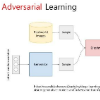Image-to-image translation has played an important role in enabling synthetic data for computer vision. However, if the source and target domains have a large semantic mismatch, existing techniques often suffer from source content corruption aka semantic flipping. To address this problem, we propose a new paradigm for image-to-image translation using Vector Symbolic Architectures (VSA), a theoretical framework which defines algebraic operations in a high-dimensional vector (hypervector) space. We introduce VSA-based constraints on adversarial learning for source-to-target translations by learning a hypervector mapping that inverts the translation to ensure consistency with source content. We show both qualitatively and quantitatively that our method improves over other state-of-the-art techniques.
翻译:图像到图像翻译在为计算机视觉提供合成数据方面发挥了重要的作用,然而,如果源和目标领域存在严重的语义错配,则现有技术往往会因源内容腐败而出现语义翻转。为了解决这一问题,我们提出了使用矢量符号结构(VSA)进行图像到图像翻译的新范式。 VSA是一个理论框架,界定了高维矢量空间中的代数操作。我们对源和目标翻译的对抗性学习实行基于VSA的限制,我们学习了高压矢量图解,使翻译与源内容保持一致。我们从质量和数量上表明,我们的方法比其他最先进的技术有所改进。



